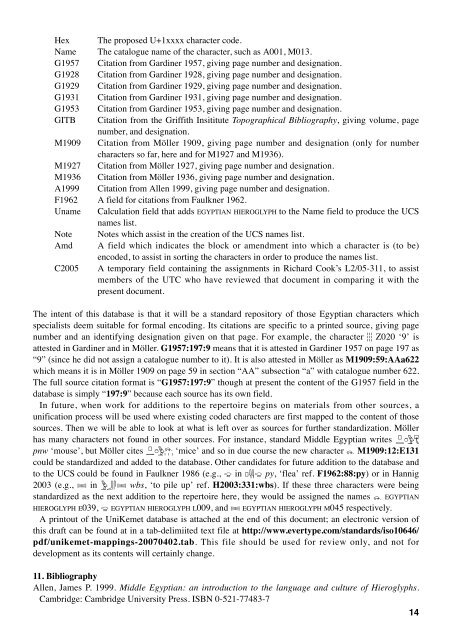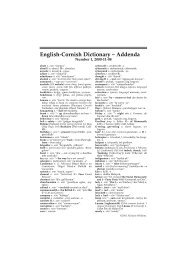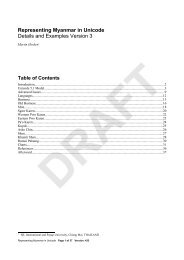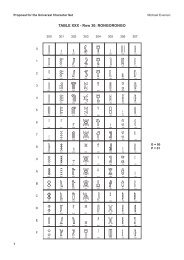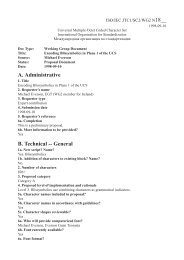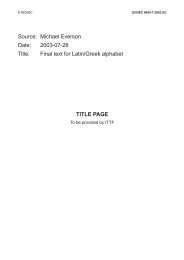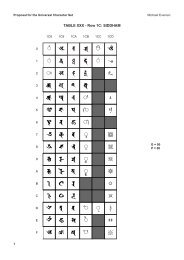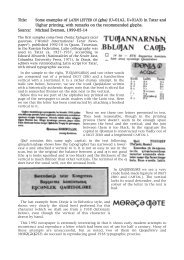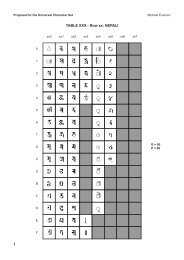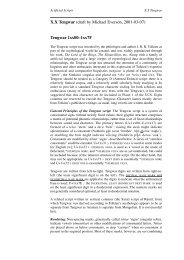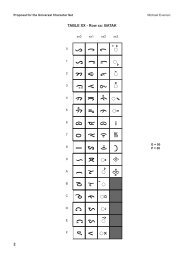ISO/IEC JTC1/SC2/WG2 N3xxx L2/07-xxx - Evertype
ISO/IEC JTC1/SC2/WG2 N3xxx L2/07-xxx - Evertype
ISO/IEC JTC1/SC2/WG2 N3xxx L2/07-xxx - Evertype
Create successful ePaper yourself
Turn your PDF publications into a flip-book with our unique Google optimized e-Paper software.
Hex The proposed U+1<strong>xxx</strong>x character code.<br />
Name The catalogue name of the character, such as A001, M013.<br />
G1957 Citation from Gardiner 1957, giving page number and designation.<br />
G1928 Citation from Gardiner 1928, giving page number and designation.<br />
G1929 Citation from Gardiner 1929, giving page number and designation.<br />
G1931 Citation from Gardiner 1931, giving page number and designation.<br />
G1953 Citation from Gardiner 1953, giving page number and designation.<br />
GITB Citation from the Griffith Insititute Topographical Bibliography, giving volume, page<br />
number, and designation.<br />
M1909 Citation from Möller 1909, giving page number and designation (only for number<br />
characters so far, here and for M1927 and M1936).<br />
M1927 Citation from Möller 1927, giving page number and designation.<br />
M1936 Citation from Möller 1936, giving page number and designation.<br />
A1999 Citation from Allen 1999, giving page number and designation.<br />
F1962 A field for citations from Faulkner 1962.<br />
Uname Calculation field that adds EGYPTIAN HIEROGLYPH to the Name field to produce the UCS<br />
names list.<br />
Note Notes which assist in the creation of the UCS names list.<br />
Amd A field which indicates the block or amendment into which a character is (to be)<br />
encoded, to assist in sorting the characters in order to produce the names list.<br />
C2005 A temporary field containing the assignments in Richard Cook’s <strong>L2</strong>/05-311, to assist<br />
members of the UTC who have reviewed that document in comparing it with the<br />
present document.<br />
The intent of this database is that it will be a standard repository of those Egyptian characters which<br />
specialists deem suitable for formal encoding. Its citations are specific to a printed source, giving page<br />
number and an identifying designation given on that page. For example, the character Ê Z020 ‘9’ is<br />
attested in Gardiner and in Möller. G1957:197:9 means that it is attested in Gardiner 1957 on page 197 as<br />
“9” (since he did not assign a catalogue number to it). It is also attested in Möller as M1909:59:AAa622<br />
which means it is in Möller 1909 on page 59 in section “AA” subsection “a” with catalogue number 622.<br />
The full source citation format is “G1957:197:9” though at present the content of the G1957 field in the<br />
database is simply “197:9” because each source has its own field.<br />
In future, when work for additions to the repertoire begins on materials from other sources, a<br />
unification process will be used where existing coded characters are first mapped to the content of those<br />
sources. Then we will be able to look at what is left over as sources for further standardization. Möller<br />
has many characters not found in other sources. For instance, standard Middle Egyptian writes ÎÏÓ<br />
pnw ‘mouse’, but Möller cites ÎÏÌ ‘mice’ and so in due course the new character Í M1909:12:E131<br />
could be standardized and added to the database. Other candidates for future addition to the database and<br />
to the UCS could be found in Faulkner 1986 (e.g., ä in ãèä py, ‘flea’ ref. F1962:88:py) or in Hannig<br />
2003 (e.g., â in åç é â wbs, ‘to pile up’ ref. H2003:331:wbs). If these three characters were being<br />
standardized as the next addition to the repertoire here, they would be assigned the names Í EGYPTIAN<br />
HIEROGLYPH E039, ä EGYPTIAN HIEROGLYPH L009, and â EGYPTIAN HIEROGLYPH M045 respectively.<br />
A printout of the UniKemet database is attached at the end of this document; an electronic version of<br />
this draft can be found at in a tab-delimiited text file at http://www.evertype.com/standards/iso10646/<br />
pdf/unikemet-mappings-20<strong>07</strong>0402.tab. This file should be used for review only, and not for<br />
development as its contents will certainly change.<br />
11. Bibliography<br />
Allen, James P. 1999. Middle Egyptian: an introduction to the language and culture of Hieroglyphs.<br />
Cambridge: Cambridge University Press. ISBN 0-521-77483-7<br />
14


